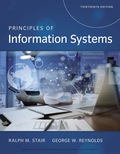
Principles of Information Systems (MindTap Course List)
13th Edition
ISBN: 9781337516945
Author: STAIR
Publisher: Cengage
expand_more
expand_more
format_list_bulleted
Question
Chapter 13, Problem 3CTQ2
Program Plan Intro
Hacker:
- A hacker denotes a skilled computer expert that uses technical knowledge to overcome a problem.
- The bugs or exploits are been used by hacker to break into computer systems.
- The hacker is able to subvert
computer security . - It mostly denotes computer criminals due to unethical tasks performed.
- It can be stated as a person who messes about with something with positive sense.
Phishing attack:
- It denotes a fraudulent e-mail sent to retrieve personal data from recipient
- It is more or less random.
- The malware may get downloaded to device.
- It may redirect into fake website to retrieve personal information.
- The information may be sold in black market for money.
Spear phishing attack:
- The fraudulent e-mails are sent to employee of an organization.
- The attack is more precise and narrow.
- The malware may get installed into particular device.
- It may be targeted to get sensitive company information or voucher money.
- The task may be targeted to provide harm to a particular organization.
Expert Solution & Answer
Want to see the full answer?
Check out a sample textbook solution
Students have asked these similar questions
Answer the question fully and accurately by providing the required files(Java Code, Two output files and written answers to questions 1-3 in a word document)meaning question 1 to 3 also provide correct answers for those questions.(note: this quetion is not graded).
.NET Interactive
Solving Sudoku using Grover's Algorithm
We will now solve a simple problem using Grover's algorithm, for which we do not necessarily know the solution beforehand. Our problem is a 2x2 binary sudoku, which in our case has two simple rules:
•No column may contain the same value twice
•No row may contain the same value twice
If we assign each square in our sudoku to a variable like so:
1
V V₁
V3
V2
we want our circuit to output a solution to this sudoku.
Note that, while this approach of using Grover's algorithm to solve this problem is not practical (you can probably find the solution in your head!), the purpose of this example is to demonstrate the
conversion of classical decision problems into oracles for Grover's algorithm.
Turning the Problem into a Circuit
We want to create an oracle that will help us solve this problem, and we will start by creating a circuit that identifies a correct solution, we simply need to create a classical function on a quantum circuit
that…
.NET Interactive
Solving Sudoku using Grover's Algorithm
We will now solve a simple problem using Grover's algorithm, for which we do not necessarily know the solution beforehand. Our problem is a 2x2 binary sudoku, which in our case has two simple rules:
•No column may contain the same value twice
•No row may contain the same value twice
If we assign each square in our sudoku to a variable like so:
1
V V₁
V3
V2
we want our circuit to output a solution to this sudoku.
Note that, while this approach of using Grover's algorithm to solve this problem is not practical (you can probably find the solution in your head!), the purpose of this example is to demonstrate the
conversion of classical decision problems into oracles for Grover's algorithm.
Turning the Problem into a Circuit
We want to create an oracle that will help us solve this problem, and we will start by creating a circuit that identifies a correct solution, we simply need to create a classical function on a quantum circuit
that…
Chapter 13 Solutions
Principles of Information Systems (MindTap Course List)
Ch. 13.1 - Prob. 1RQCh. 13.1 - Prob. 2RQCh. 13.1 - Prob. 1CTQCh. 13.1 - Prob. 2CTQCh. 13.2 - Prob. 1RQCh. 13.2 - Prob. 2RQCh. 13.2 - Prob. 1CTQCh. 13.2 - Prob. 2CTQCh. 13 - Prob. 1SATCh. 13 - Prob. 2SAT
Ch. 13 - Prob. 3SATCh. 13 - Prob. 4SATCh. 13 - Prob. 5SATCh. 13 - Prob. 6SATCh. 13 - Prob. 7SATCh. 13 - Prob. 8SATCh. 13 - Prob. 9SATCh. 13 - Prob. 10SATCh. 13 - Prob. 11SATCh. 13 - Prob. 12SATCh. 13 - Prob. 13SATCh. 13 - Prob. 14SATCh. 13 - Prob. 1RQCh. 13 - Prob. 2RQCh. 13 - Prob. 3RQCh. 13 - Prob. 4RQCh. 13 - Prob. 5RQCh. 13 - Prob. 6RQCh. 13 - Prob. 7RQCh. 13 - Prob. 8RQCh. 13 - Prob. 9RQCh. 13 - Prob. 10RQCh. 13 - Prob. 11RQCh. 13 - Prob. 12RQCh. 13 - Prob. 13RQCh. 13 - Prob. 14RQCh. 13 - Prob. 15RQCh. 13 - Prob. 16RQCh. 13 - Prob. 1DQCh. 13 - Prob. 2DQCh. 13 - Prob. 3DQCh. 13 - Prob. 4DQCh. 13 - Prob. 5DQCh. 13 - Prob. 6DQCh. 13 - Prob. 7DQCh. 13 - Prob. 1PSECh. 13 - Prob. 2PSECh. 13 - Prob. 1TACh. 13 - Prob. 2TACh. 13 - Prob. 3TACh. 13 - Prob. 1WECh. 13 - Prob. 2WECh. 13 - Prob. 3WECh. 13 - Prob. 1CECh. 13 - Prob. 2CECh. 13 - Prob. 3CECh. 13 - Prob. 1CTQ1Ch. 13 - Prob. 2CTQ1Ch. 13 - Prob. 3CTQ1Ch. 13 - Prob. 1CTQ2Ch. 13 - Prob. 2CTQ2Ch. 13 - Prob. 3CTQ2
Knowledge Booster
Similar questions
- Please answer Java OOP Questions.arrow_forward.NET Interactive Solving Sudoku using Grover's Algorithm We will now solve a simple problem using Grover's algorithm, for which we do not necessarily know the solution beforehand. Our problem is a 2x2 binary sudoku, which in our case has two simple rules: •No column may contain the same value twice •No row may contain the same value twice If we assign each square in our sudoku to a variable like so: 1 V V₁ V3 V2 we want our circuit to output a solution to this sudoku. Note that, while this approach of using Grover's algorithm to solve this problem is not practical (you can probably find the solution in your head!), the purpose of this example is to demonstrate the conversion of classical decision problems into oracles for Grover's algorithm. Turning the Problem into a Circuit We want to create an oracle that will help us solve this problem, and we will start by creating a circuit that identifies a correct solution, we simply need to create a classical function on a quantum circuit that…arrow_forwardNeed help with this in python!arrow_forward
arrow_back_ios
SEE MORE QUESTIONS
arrow_forward_ios
Recommended textbooks for you
 Fundamentals of Information SystemsComputer ScienceISBN:9781337097536Author:Ralph Stair, George ReynoldsPublisher:Cengage Learning
Fundamentals of Information SystemsComputer ScienceISBN:9781337097536Author:Ralph Stair, George ReynoldsPublisher:Cengage Learning Principles of Information Systems (MindTap Course...Computer ScienceISBN:9781305971776Author:Ralph Stair, George ReynoldsPublisher:Cengage Learning
Principles of Information Systems (MindTap Course...Computer ScienceISBN:9781305971776Author:Ralph Stair, George ReynoldsPublisher:Cengage Learning Principles of Information Systems (MindTap Course...Computer ScienceISBN:9781285867168Author:Ralph Stair, George ReynoldsPublisher:Cengage Learning
Principles of Information Systems (MindTap Course...Computer ScienceISBN:9781285867168Author:Ralph Stair, George ReynoldsPublisher:Cengage Learning Management Of Information SecurityComputer ScienceISBN:9781337405713Author:WHITMAN, Michael.Publisher:Cengage Learning,
Management Of Information SecurityComputer ScienceISBN:9781337405713Author:WHITMAN, Michael.Publisher:Cengage Learning, Principles of Information Security (MindTap Cours...Computer ScienceISBN:9781337102063Author:Michael E. Whitman, Herbert J. MattordPublisher:Cengage Learning
Principles of Information Security (MindTap Cours...Computer ScienceISBN:9781337102063Author:Michael E. Whitman, Herbert J. MattordPublisher:Cengage Learning

Fundamentals of Information Systems
Computer Science
ISBN:9781337097536
Author:Ralph Stair, George Reynolds
Publisher:Cengage Learning

Principles of Information Systems (MindTap Course...
Computer Science
ISBN:9781305971776
Author:Ralph Stair, George Reynolds
Publisher:Cengage Learning

Principles of Information Systems (MindTap Course...
Computer Science
ISBN:9781285867168
Author:Ralph Stair, George Reynolds
Publisher:Cengage Learning

Management Of Information Security
Computer Science
ISBN:9781337405713
Author:WHITMAN, Michael.
Publisher:Cengage Learning,


Principles of Information Security (MindTap Cours...
Computer Science
ISBN:9781337102063
Author:Michael E. Whitman, Herbert J. Mattord
Publisher:Cengage Learning